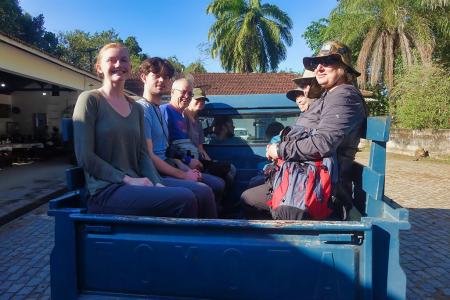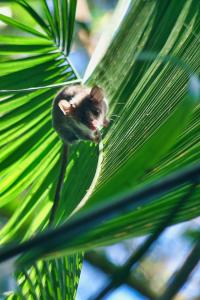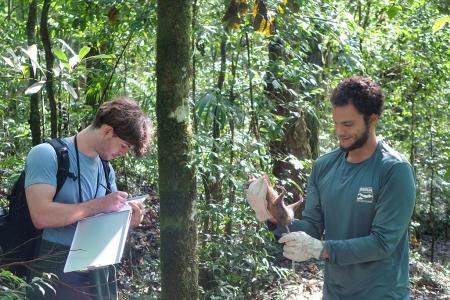A Day in the Life of a Reforestation Volunteer in Brazil
By Ashley Junger, Earthwatch Multimedia and Grants Manager
What's it like to join Brazil's reforestation efforts?
6:15—Waking up in the midst of nature
My alarm goes off at 6:15, and I groggily get out of my bed. I’m not a morning person in any sense, but the best time to spot wildlife is at dawn and dusk. And I’m not about to waste any sunrises when I have the rare opportunity to visit one of the world’s most biodiverse hotspots.
I’m the only volunteer in my cabin, so I don’t have to worry about waking anyone else up while I throw on some cargo pants, a t-shirt, and a generous amount of bug spray. After brushing my teeth and grabbing my camera, I head out into the early morning mist.
6:30—Stepping onto the lush trails
Several trails snake through the grounds of Reserva Ecológica de Guapiaçu (REGUA), all of which are available to volunteers during their free time. There have been wildlife spottings on all of them, including capybara (the world’s largest rodent), tapirs, and a plethora of birds. This morning, I decided to head up towards the lodge, where there’s a lookout tower. I figure I have a decent shot of seeing a lot of different animals from a high-up vantage point. I head up the dirt road that runs in front of my cabin. The walk is all uphill, but it only takes about ten minutes before I’m at the base of the tower.

6:40—Morning in the mountain mist
I quietly walk up the metal spiral stairs to the top of the lookout tower, trying not to make any loud noises that’d scare away nearby wildlife. Once I get to the top, I see Tom and Lisa, a father-daughter volunteer duo, scanning the jagged mountains. I ask if they’ve seen anything interesting, but they tell me they haven’t had any luck yet.
The three of us quietly watch the mist for movement or noise. As we wait, mountain mist floods the valley. From my office in Boston, I usually observe apartment buildings and busy roads, so even without wildlife, this spectacular view is invigorating and makes me grateful for the opportunity to sit in this remote spot, listening to bird calls and enjoying the astonishing wilderness that supports 5% of the vertebrate species on Earth.
Eventually, we decide to give up on spotting any large animals and head back for breakfast.
7:30—Egg-cited to start the day
All volunteers meet in the main courtyard every morning. The surrounding buildings host the reserve’s offices, lab, kitchen, and classroom. Breakfast, lunch, and dinner are served at the picnic tables outside the kitchen.
The breakfast spread has already been laid out by the wonderful women in charge of the kitchen by the time I arrive. I grab a cup of hot coffee and load my plate with a roll, cheese, eggs, and some fresh fruit. The papaya is so delicious I have to stop myself from eating the whole bowl and depriving the other volunteers.
I join the rest of my cohort at one of the tables. Besides Tom and Lisa, there are five other volunteers on my team. A group of three women, Peggy, Kathleen, and Diana, who’ve gone on multiple expeditions together. Sam, a young Londoner on his first foray into environmental science. And a biology professor, Jared, with an impressive wealth of knowledge about the area’s birds.
8:30—En route to conservation
We finish breakfast early and have to wait for the truck to take us to the field site. Some of us chat in the courtyard while others go down the road to spot birds. Small, colorful birds flock to the large trees in front of the epiphyte and orchid greenhouse. Sloths had been spotted in the area just last week, but I wasn't lucky enough to see any.
We pile into the back of a charming blue pickup truck and drive down the dirt roads toward the field site. Just outside of REGUA, we pass by farms growing chili, guava, and cassava. We zoom down the bumpy dirt roads, mountains rising in the background.
8:45—The science of forest revival
We split into two teams. Half of the volunteers go with Dr. Manoel Muanis, the project's leading scientist, and the other half go with Julian Willmer, a biologist working with Manoel. Manoel's cohort always checks the traps higher up the mountain, and I want to hike as much as possible, so I volunteer to go with him.
The project aims to evaluate small mammal responses to reforestation. A large, healthy population of small mammals indicates that seeds are being dispersed, the vegetation is healthy enough to provide a variety of habitats, and predatory animals have plenty of prey.
Manoel plans to compare small mammal biodiversity at unforested/pasture sites, recently planted forests, and old-growth forests to see how populations change with habitat. If mammal populations in newer forests resemble those in old-growth forests, we can deduce that the ecosystem is recovering and supporting biodiversity. If they don't grow and diversify like the old-growth forest, scientists can infer that the reforestation efforts aren't restoring biodiversity and can investigate further.
This information is especially helpful as the reserve—along with government and NGO organizations across Brazil—undertakes reforestation projects to try to reconnect Brazil’s remaining forest fragments. Today, only 11% of the Atlantic Forest still stands, and what does remain is disconnected. Increasing the size of the forest and ensuring wildlife can move through it freely is essential to safeguarding the unbelievable array of wildlife that lives there.
My team is surveying small mammals in an old-growth forest. The information we collect will be compared to future teams' data from other habitat types. The trees tower over us, and the understory is crowded with young trees and shrubs. We hike 20 minutes up the mountain to reach our first line. A trail tree flag marks each trap location. Each team checks two 15-point lines with three traps per point. I’ll do the math for you; that’s 180 traps for us to check each morning!
By now, the sun is shining, and the day is hot. To prevent animals from overheating, we must check traps quickly. We leap from point to point, checking traps for visitors. Most traps are empty except for a ball of banana-oatmeal-peanut butter bait (or butterflies and beetles stealing a bite), but occasionally a volunteer will shout, “I think we’ve got one!”
Manoel rushes up and unloads his backpack to produce a linen bag, scales, measuring tape, ear tags, and alcohol. Manoel moves the animal from the cage to the bag. One of the volunteers weighs it on the scale. Then Manoel takes the mammal out of the bag, which is harder than it sounds and stressful because the animals can escape easily. Volunteers measure the animal's body and tail length, Manoel checks for parasites, and we either check its ear tags or, for newly captured animals, spray alcohol on new tags and use specialized pliers to pop a tag on each ear.
If the animal we capture is a smaller mammal, like a striped Atlantic Forest rat (Delomys dorsalis) or South American field mouse (Akodon cursos), we have to work quickly as they get easily overstressed. A few times Manoel has let the animal go early if he feels it’s getting too overwhelmed. If it’s a bigger animal, like a four-eyed opossum (Philander trenatus) or a brown opossum (Metachirus Nidicaudaus), we have a bit more time.
On today’s hike, my team captured four forest rats—half of our record of eight animals in one day. The other team also captured four animals, making our total eight small mammal captures. While processing the animals is exciting and having a lot of visitors feels like a “good” day, the absence of animals is also valuable information for Manoel and Julian. So, we get to feel successful no matter how many animals we capture.
11:30—A midday respite
We finish fieldwork early, so some volunteers walk back to REGUA instead of taking the truck. The walk takes a little over an hour and lets us birdwatch, explore an abandoned church, and enjoy the scenery.
By the time we reach the courtyard, lunch is served. Rice and black beans are always a staple, but the rest of the table is always covered in a mouth-watering array of Brazilian dishes. I pile my plate high—all of the hiking and animal handling has me eating a lot more than usual, not to mention all of the delicious food that’s available.
After lunch, we have some free time every day. Some volunteers shower or nap. Some walk the trails, enjoying the forest and birds. Jared and I go to a nearby spot to look for Red-legged seriemas, large, goofy-looking predatory birds that like cow fields. We realize it's too hot to be outside at midday, so we return to base camp.
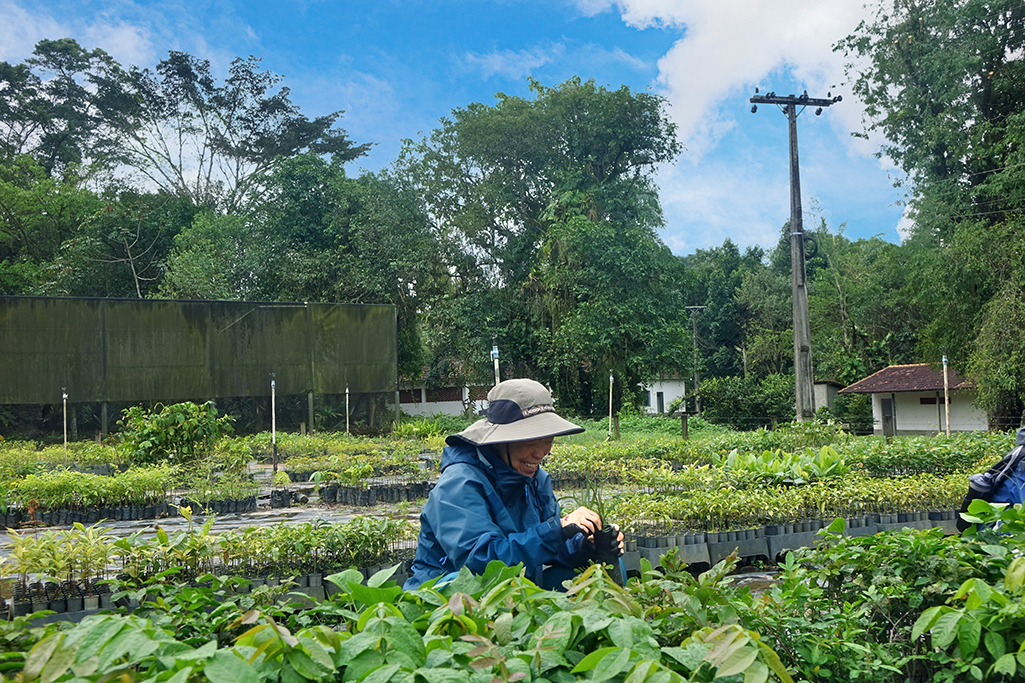

2:30—Getting our hands dirty
Along with monitoring the mammal populations, the other main component of this project is helping to replant the Atlantic Forest. While some areas could be left alone, and eventually, a fully-functional old growth forest would take over, many areas that have been clear-cut are now overrun with shrubs and grasses that won’t allow trees to grow. That’s where the REGUA foresters come in. Year-round REGUA employees run the nursery, collecting seeds from the surrounding forests, planting the seeds, nurturing the seedlings, and ensuring there’s a steady supply of saplings to fuel the reforestation efforts.
I worked on a winter team (the dry season) and filled soil bags for tree seedlings and weeded older saplings to keep them growing. The REGUA workers and Earthwatch volunteers will plant the trees we helped grow in the summer rainy season. Hopefully, these trees will stand for decades to come, restoring the globally vital rainforests.
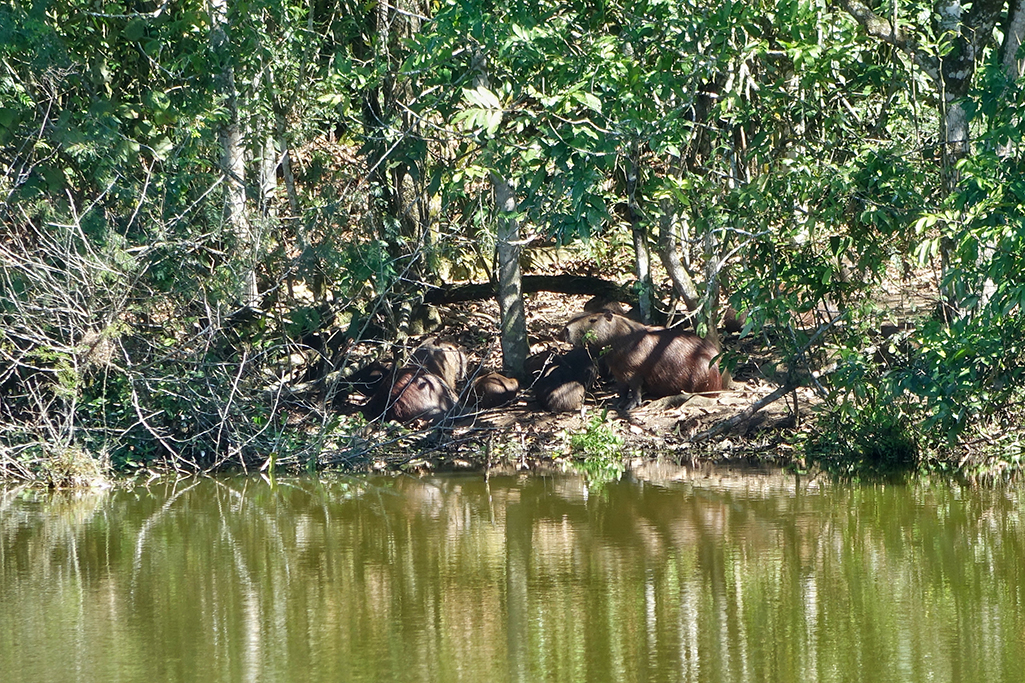
4:30—A walk Along the Yellow Trail
We get a little free time in the evening. I took the yellow trail to a small lake. This area is full of wildlife, so I figure the hot day means more animals are near the water. Droves of cattle egrets glide over the lake, settling in groups on the small islands and spotting the lake.
After a few minutes, I spot strange lumps on an island's shore. The tree shadows make them hard to see, but my camera’s zoom reveals a group of capybaras! This was the animal I was most hoping to see while I was in Brazil. They can weigh 175 pounds and resemble giant guinea pigs. I saw about a dozen of these adorable, unique creatures lounging on the shoreline. I spend the rest of my free time watching them nap and gaze lazily at the calm lake.
5:30—Fieldwork insights
Tonight, we get a lecture from Manoel to learn more about reforestation efforts in the Atlantic Forest, the ways REGUA is assisting those efforts, and the ways this expedition will support those efforts.

6:30—Cheers!
Back home, a 6:30 dinner would be way too early, but with all the physical activity here, I’m starving by the time 6:30 rolls around. Once again, there’s a wide array of delicious Brazilian fare, and I pile a little bit of everything onto my plate.
Manoel and Julian always eat meals with us, allowing us to pick their brains not only about the research project but also about Brazilian life in general. Tonight, we talk about how different political leaders have supported (or hindered) the environmental movement in the country and how the changing governmental positions have impacted funding for REGUA. Eventually, that topic transitions to everyone’s pets, and pictures of fluffy companions are passed around the table.
A lot of the volunteers stick around after dinner to chat and share a beer, but after a long day, we can only resist the call of our beds for a short time. We all head back to our cabins to rest up for the next day on Wildlife and Reforestation in Brazil.
Sign up for the Earthwatch Newsletter
Be the first to know about new expeditions, stories from the field, and exciting Earthwatch news.
.
.
.
